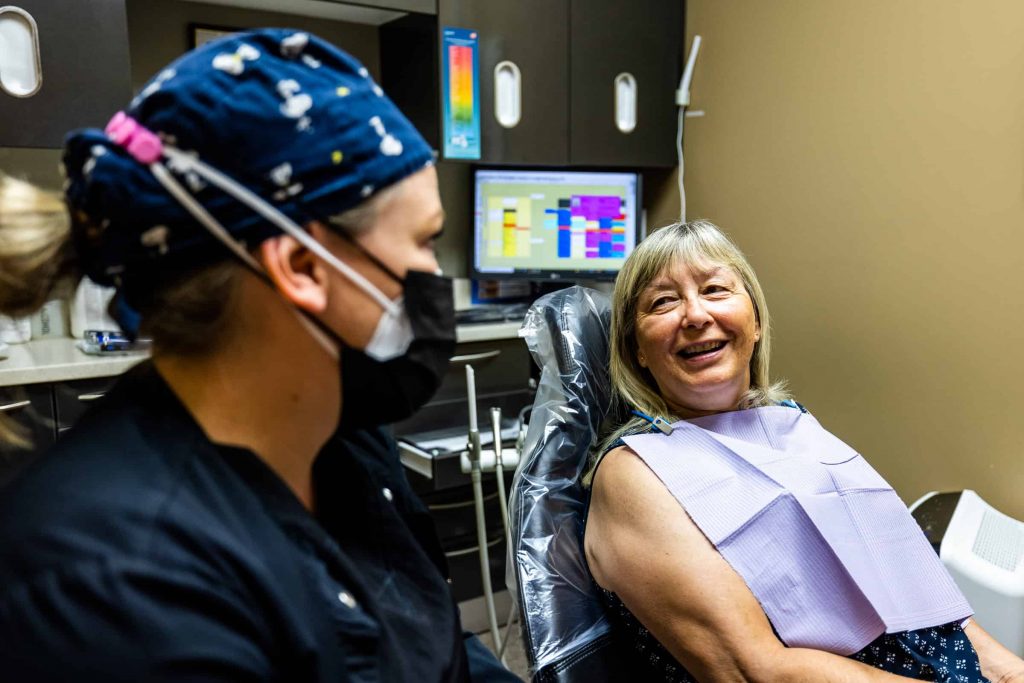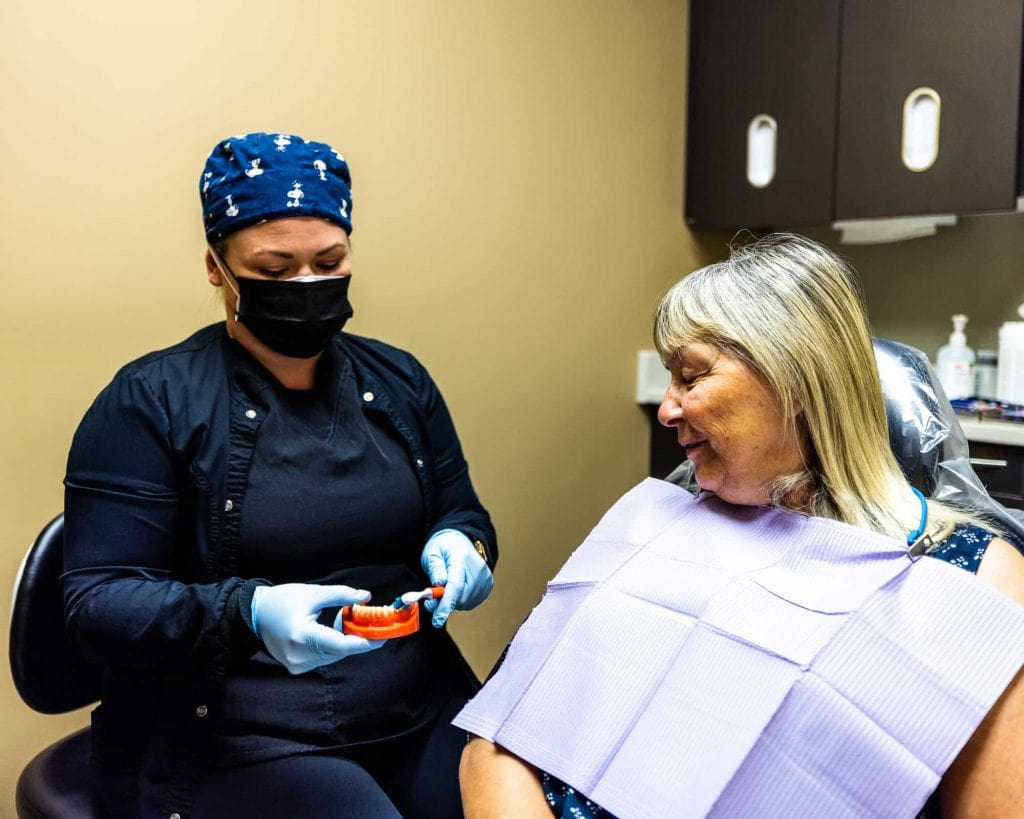What is Bone Grafting
Periodontal disease is the leading cause of bone loss in the oral cavity, though there are others such as ill-fitting dentures and facial trauma. The bone grafting procedure is an excellent way to replace lost bone tissue and encourage natural bone growth. Bone grafting is a versatile and predictable procedure which fulfills a wide variety of functions.
A bone graft may be required to create a stable base for dental implant placement, to halt the progression of gum disease, or to make the smile appear more aesthetically pleasing.

What are some of the reasons for Bone Grafting?
There are a wide variety of reasons why bone grafting may be the best option for restoring jaw bone.
Dental implants – Implants are the preferred replacement method for missing teeth because they restore full functionality to the mouth; however, implants need to be firmly anchored to the jawbone to be effective. If the jawbone lacks the necessary quality or quantity of bone, bone grafting can strengthen and thicken the implant site.
Sinus lift – A sinus lift entails elevating the sinus membrane and grafting bone onto the sinus floor so that implants can be securely placed.
Ridge augmentation – Ridges in the bone can occur due to trauma, injury, birth defects, or severe periodontal disease. The bone graft is used to fill in the ridge and make the jawbone a uniform shape.
Nerve repositioning – If the inferior alveolar nerve requires movement to allow for the placement of implants, a bone grafting procedure may be required. The inferior alveolar nerve allows feeling and sensation in the lower chin and lip.
Book Your Dental Appointment Today
What is Gum Grafting?
A gum graft (also known as a gingival graft or periodontal plastic surgery), is a collective name for surgical periodontal procedures that aim to cover an exposed tooth root surface with grafted oral tissue.
Exposed tooth roots are usually the result of gingival recession due to periodontal disease. There are other common causes, including overly aggressive brushing and trauma.

Reasons for Gum Grafting
Gum grafting is a common periodontal procedure. Though the name might sound frightening, the procedure is commonly performed with excellent results.
Here are some of the major benefits associated with gum grafting:
Reduced sensitivity – When the tooth root becomes exposed, eating or drinking hot or cold foods can cause extreme sensitivity to the teeth. Gum grafting surgery permanently covers the exposed root, helps reduce discomfort, and restores the good health of the gums.
Improved appearance – Periodontal disease is characterized by gum recession and inflammation. Gum recession and root exposure can make the teeth look longer than normal and the smile to appear “toothy.” Gum grafting can make the teeth look shorter, more symmetrical and generally more pleasing to look at. In addition, adjacent tissue can be enhanced and augmented during the procedure for aesthetic purposes.
Improved gum health – Periodontal disease can progress and destroy gum tissue very rapidly. If left untreated, a large amount of gum tissue can be lost in a short period of time. Gum grafting can help halt tissue and bone loss; preventing further problems and protecting exposed roots from further decay.
Book Your Dental Appointment Today
Ask Us Anything
There are several types of dental bone grafts. The following are the most common:
Autogenous bone graft – In this type of graft the bone is removed from elsewhere in the body and implanted in the mouth. Common donor sites for bone grafting include the iliac section of the pelvis, the chin and the posterior third molar areas of the jaw. If large amounts of bone need to be harvested, the hip or the shin bone (tibia) is generally used.
Allograft – Synthetic bone (manmade) can be created in the laboratory and used in the bone grafting procedure. Bone can also be obtained from a bone bank (cadaver bone).
Xenograft – This is the implantation of bovine (cow) bone. A xenograft is perfectly safe and has been used successfully; ample bone can be obtained, and a secondary donor site is not necessary.
Bone grafting is a fairly simple procedure that can be performed under local anesthetic; however, if large amounts of bone area need to be grafted, general anesthetic may be required.
Initially, the grafting material needs to either be harvested or prepared for insertion. A small incision is made in the gum tissue and then gently separated from the bone. The bone grafting material is then placed at the affected site.
The bone regeneration process may be aided by:
Gum/bone tissue regeneration – A thin barrier (membrane) is placed below the gum line over the grafting material. This barrier creates enough space for healthy tissue to grow and separates the faster growing gum tissue from the slower growing fibers. This means that bone cells can migrate to the protected area and grow naturally.
Tissue stimulating proteins – Enamel matrix proteins occur during natural tooth development. Emdogain is a matrix protein product which is usually placed on the affected site before the gum is sutured. It mediates the formation of accellular cementum on the tooth which provides a foundation to allow periodontal attachment to occur. Tissue stimulating proteins help create lost support in areas affected by periodontal defects.
Platelet-rich growth factors – A high platelet concentration liquid can be used to create a blood clot at the site of a wound. It has recently been discovered that PRGF also stimulates bone growth – meaning a denser graft in a shorter time period.
The gum is sutured in place and a follow-up appointment will need to be made within 10 days to assess progress. Bone grafting is a highly successful treatment and a good base for further periodontal restorations.
Once the need for gum grafting surgery has been determined, there are several treatments the dentist will want perform before gum grafting takes place. First, the teeth must be thoroughly cleaned supra and subgingivally to remove calculus (tartar) and bacteria. The dentist can also provide literature, advice and educational tools to increase the effectiveness of homecare and help reduce the susceptibility of periodontal disease in the future.
The gum grafting procedure is usually performed under local anesthetic. The exact procedure will depend much on whether tissue is coming from the patient’s palate or a tissue bank.
Initially, small incisions will be made at the recipient site to create a small pocket to accommodate the graft. Then a split thickness incision is made and the connective tissue graft is inserted into the space between the two sections of tissue. The graft is usually slightly larger than the recession area, so some excess will be apparent.
Sutures are often placed to further stabilize the graft and to prevent any shifting from the designated site. Surgical material is used to protect the surgical area during the first week of healing. Uniformity and healing of the gums will be achieved in approximately six weeks.
Here are some of the most common types of gum grafting:
Free gingival graft – This procedure is often used to thicken gum tissue. A layer of tissue is removed from the palate and relocated to the area affected by gum recession. Both sites will quickly heal without permanent damage.
Subepithelial connective tissue graft – This procedure is commonly used to cover exposed roots. Tissue is removed fairly painlessly from the outer layer of the palate and relocated to the site of gum recession.
Acellular dermal matrix allograft – This procedure uses medically processed, donated human tissue as a tissue source for the graft. The advantage of this is procedure is that there is no need for a donor site from the patient’s palate (and thus, less pain).

